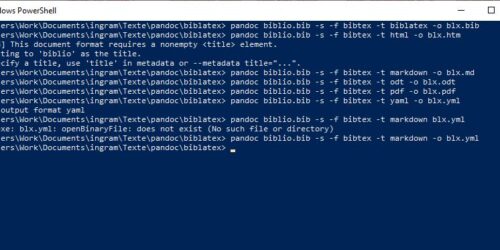Pandoc is a command line tool for converting from one markup to another. It uses a largely enhanced markdown syntax as intermediate format. This allows for adding input and output filters for only one format instead of writing them for every possible conversion anew. In case you don’t know what markdown is: It was invented for writing HTML quickly by using markup which was common in plain *.txt files. Markdown variants are used fi. by the Wikipedia editor or GitHub README files.. An universal markup converter needs much more elements than is necessary for HTML (eg. footnotes, citations, math etc.). But of course, this approach has its limits. Pandoc supports a lot of elements common in various formats, but cannot provide all special cases which were ever implented in one of its filter formats. Remark that Pandoc my be inside other markdown formats. R markdown is in fact Pandoc markdown, as RStudio is shipped with Pandoc.
In version 2.12 I have used for this post, Pandoc returns the following input formats
$ pandoc --list-input-formats biblatex bibtex commonmark commonmark_x creole csljson csv docbook docx dokuwiki epub fb2 gfm haddock html ipynb jats jira json latex man markdown markdown_github markdown_mmd markdown_phpextra markdown_strict mediawiki muse native odt opml org rst t2t textile tikiwiki twiki vimwiki
and the following output formats:
$ pandoc --list-output-formats asciidoc asciidoctor beamer biblatex bibtex commonmark commonmark_x context csljson docbook docbook4 docbook5 docx dokuwiki dzslides epub epub2 epub3 fb2 gfm haddock html html4 html5 icml ipynb jats jats_archiving jats_articleauthoring jats_publishing jira json latex man markdown markdown_github markdown_mmd markdown_phpextra markdown_strict mediawiki ms muse native odt opendocument opml org pdf plain pptx revealjs rst rtf s5 slideous slidy tei texinfo textile xwiki zimwiki
As you can see,, both BibTeΧ and biblatex are available as input and output format. It is not possible to convert to any format and it doesn’t change field names between BibTeΧ and biblatex. If this is your use case, you are better off with Biber’s tool mode. The markdown format produces a file in YAML format which is Pandocs way to store document metadata. This can be used as external bibliography database. In principle, this has nothing to do with writing LaTeΧ files. The same holds for CSL JSON. You can only convert between these.
There are two ways to add bibliographic data to a document: as document metadata or as external bibliography. I will restrict myself to the latter. If you want to get a LaTeΧ file with biblatex commands, there is a --biblatex option. It will not work with other output formats (even not with PDF, although Pandoc runs LaTeΧ for it!). For other document formats there are the options --csl, --citeproc and --bibliography. The first one eats a CSL (Citation Style Language) file, the middle one a file were the refernces are processed and the latter a database in one of the aforementioned formats. CSL files are easy to obtain. There is big repository on Zotero and they are shipped with Citavi.
The issues with Pandoc very much resemble those with LyΧ. The Pandoc referencing system provides common bibliographic facilities but not fine granulated possibilities of a special purpose package like biblatex-archaeology. Although I like it very much, I don’t think it is made for huge publication projects. Besides the limited bibliography features remark that there is no semantic markup in Pandoc markdown.


Leave a Reply